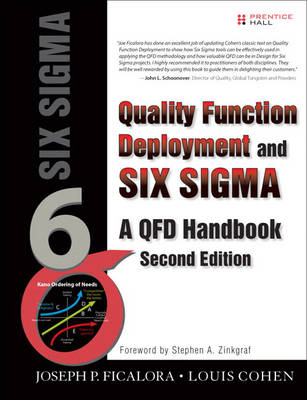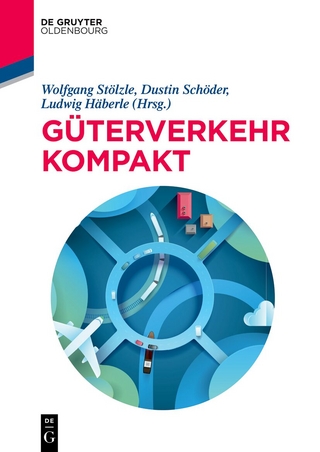
Quality Function Deployment and Six Sigma, Second Edition
Prentice Hall (Verlag)
978-0-13-513835-9 (ISBN)
- Titel ist leider vergriffen;
keine Neuauflage - Artikel merken
Quality Function Deployment (QFD) techniques have helped thousands of organizations deliver higher-quality, more user-focused product designs. Now, Lou Cohen’s classic guide to QFD has been thoroughly updated to fully align QFD with Design for Six Sigma (DFSS) and other state-of-the-art Six Sigma methodologies.
Revised by world-class Six Sigma expert Joe Ficalora and his team at Sigma Breakthrough Technologies, this new edition’s up-to-date perspective on QFD reflects dozens of successful Six Sigma and DFSS deployments. They offer a start-to-finish methodology for implementing QFD, and systematically illuminate powerful linkages between QFD and Six Sigma, DFSS, Marketing for Six Sigma (MFSS), and Technology for Six Sigma (TFSS). An expanded, start-to-finish case study demonstrates how QFD should function from all angles, from design and marketing to technology and service.
Learn how to
Identify the roles and advantages of QFD in today’s global business environment
Understand every element of the House of Quality (HOQ)
Use QFD to drive more competitive product and service development
Move from the processes you have to the processes you want
Anticipate QFD’s unique challenges, overcome its obstacles, and deploy it successfully
Extend the HOQ concept all the way through project completion
Deploy powerful Voice of the Customer (VOC) techniques throughout all phases of development, not just planning
Adapt QFD for software development, service development, and organizational planning
Whether you’re working in operations, engineering, marketing, technology, or service development, this book will help you drive maximum value from all your Six Sigma, QFD, VOC, and DFSS investments.
Joe Ficalora is currently the president of Global Services at Sigma Breakthrough Technologies, Inc. (SBTI), a consulting firm for manufacturing, quality, and engineering services, with specialties in Six Sigma and Lean Enterprise applications. In this role, Mr. Ficalora is responsible for the worldwide deployment of SBTI methodologies and for managing the international partners of SBTI. Mr. Ficalora has more than 20 years of industrial experience in project management, engineering, manufacturing, and quality control. He first came across QFD while at AlliedSignal, now Honeywell, in 1991. His involvement with Quality tools and techniques has been continuous since that time. He designed and developed the highly acclaimed SBTI Six Sigma Master Black Belt Program. He has led Six Sigma deployments in Operations and Engineering at several clients, including Executive and Champion rollout sessions. Mr. Ficalora holds an MEE from Stevens Institute of Technology, and a BS in physics from Rensselaer Polytechnic Institute. Mr. Ficalora has worked and is certified as a Black Belt and Master Black Belt. He has consulted for clients in the industries of aerospace, medical devices, beverages, health care, and in manufacturing of food packaging, electronics, metal, glass, and plastics. His current interests include DFSS in renewable energy and energy conservation, as well as future energy options, including nuclear fusion. His current interests also include investment performance predictions, economics, crime statistics, and crime prevention within the USA. He has mentored, and designed and taught workshops to Executives, Champions, Master Black Belts, Black Belts, and Green Belts in Design for Six Sigma, Six Sigma in Manufacturing, and Transactional Business projects worldwide. Mr. Ficalora is a top-rated and sought-after instructor and speaker in these areas. Mr. Ficalora also holds several patents in lasers and optical devices and a patent in process improvement. He is an active member in IEEE and ISSSP. Lou Cohen was a product developer, computer and software development manager, quality manager, and consultant during 41 years of professional life. He lived and worked in Japan in 1984, where he extensively studied quality and productivity methods, including a detailed study of the theories of Dr. W. Edwards Deming. Upon his return to the U.S., he became a nationally known expert in the use of Quality Function Deployment. He has helped his clients use QFD in many diverse industries, including electric-power utilities, financial services, medical instruments, software, communications and telecommunications, laundry detergents, aerospace components, and office furniture. Now in retirement, he lives in Cambridge,Massachusetts.
Foreword xv
Preface xvii
Acknowledgments xxiii
About the Authors xxv
Part I: ABOUT QUALITY FUNCTION DEPLOYMENT AND SIX SIGMA 1
Chapter 1: What Are QFD and Six Sigma? 3
1.1 Brief Capsule Description 3
1.2 What Is Six Sigma? 10
1.3 History of QFD and Six Sigma 19
1.4 What Is QFD Being Used for Today? 27
1.5 Discussion Questions 29
Chapter 2: How QFD Fits in the Organization 31
2.1 The Challenge to the Organization 32
2.2 Increasing Revenues 34
2.3 Decreasing Costs 35
2.4 Dealing with Market Shifts and Cycle-Time Reduction 36
2.5 Challenges to Rapid Product Development 38
2.6 QFD’s Role as Communication Tool 43
2.7 Concurrent Engineering: A Paradigm Shift 44
2.8 Kano’s Model 47
2.9 The Lessons of Kano’s Model 52
2.10 Summary 53
2.11 Discussion Questions 53
Chapter 3: Tying QFD to Design, Marketing, and Technology 55
3.1 QFD and Design for Six Sigma (DFSS) 56
3.2 QFD and Six Sigma Process Design 63
3.3 QFD and Marketing for Six Sigma 67
3.4 QFD and Technology for Six Sigma 69
3.5 Summary 75
3.6 Discussion Questions 76
Part II: QFD AT GROUND LEVEL 77
Chapter 4: Support Tools for QFD 79
4.1 The Seven Management and Planning Tools 80
4.2 Affinity Diagram 81
4.3 Tree Diagram 89
4.4 The Matrix Diagram 91
4.5 The Prioritization Matrix 93
4.6 Additional Tools for QFD Practitioners from Six Sigma 97
4.7 Summary 109
4.8 Discussion Questions 109
Chapter 5: Overview of the House of Quality 113
5.1 Tour of the House of Quality 114
5.2 Summary 118
5.3 Discussion Questions 119
Chapter 6: Customer Needs and Benefits Section 121
6.1 Gather the Voice of the Customer 123
6.2 Sort the Voice of the Customer into Major Categories 126
6.3 Structure the Needs 137
6.4 Summary 139
6.5 Discussion Questions 140
Chapter 7: The Product Planning Matrix 141
7.1 Importance to the Customer 144
7.2 Customer Satisfaction Performance 151
7.3 Competitive Satisfaction Performance 154
7.4 Goal and Improvement Ratio 158
7.5 Sales Point 162
7.6 Raw Weight 164
7.7 Normalized Raw Weight 166
7.8 Cumulative Normalized Raw Weight 168
7.9 Summary 170
7.10 Discussion Questions 171
Chapter 8: Substitute Quality Characteristics (Technical Response) 173
8.1 Top Level Performance Measurements 176
8.2 Product Functions 181
8.3 Product Subsystems 184
8.4 Process Steps 186
8.5 Summary 189
8.6 Discussion Questions 190
Chapter 9: Impacts, Relationships, and Priorities 191
9.1 Amount of Impact 192
9.2 Impact Values 196
9.3 Priorities of Substitute Quality Characteristics 197
9.4 Negative Impacts 198
9.5 Many-to-Many Relationships 200
9.6 Summary 202
9.7 Discussion Questions 202
Chapter 10: Technical Correlations 203
10.1 Meaning of Technical Correlations 203
10.2 Responsibility and Communication 206
10.3 Correlations Network 207
10.4 Other Considerations 209
10.5 Summary 210
10.6 Discussion Questions 210
Chapter 11: Technical Benchmarks 211
11.1 Benchmarking Performance Measures 213
11.2 Benchmarking Functionality 214
11.3 Summary 215
11.4 Discussion Questions 215
Chapter 12: Targets 217
12.1 Numerical Targets 219
12.2 Nonnumeric Targets 223
12.3 Summary 225
12.4 Discussion Questions 226
Part III: QFD FROM 10,000 FEET 227
Chapter 13: The Larger Picture: QFD and Its Relationship to the Product Development Cycle 229
13.1 Cross-Functional Communication 230
13.2 Enhanced QFD and Concept Selection 232
13.3 Robustness of Product or Service 240
13.4 Summary 242
13.5 Discussion Questions 243
Chapter 14: QFD in an Imperfect World 245
14.1 Marketing Functions in Engineering-Driven Environments 246
14.2 Engineering Functions in Marketing-Driven Environments 247
14.3 QFD in Engineering-Driven Organizations 248
14.4 QFD in Marketing-Driven Organizations 250
14.5 Manufacturing and QFD 251
14.6 Sales and QFD 251
14.7 Service and QFD 252
14.8 Exerting Influence Beyond Organizational Barriers 253
14.9 Summary 255
14.10 Discussion Questions 256
Part IV: QFD HANDBOOK 257
Chapter 15: Introduction to the Handbook 259
15.1 The QFD Manager’s Role 261
15.2 Summary 262
Chapter 16: Phase 0: Planning QFD 263
16.1 Establish Organizational Support 264
16.2 Determine Objectives 265
16.3 Decide on the Customer 266
16.4 Decide on the Time Horizon 277
16.5 Decide on the Product Scope 278
16.6 Decide on the Team and Its Relationship to the Organization 279
16.7 Create a Schedule for the QFD 281
16.8 Acquire the Facilities and Materials 297
16.9 Summary 300
16.10 Discussion Questions 301
Chapter 17: Phase 1: Gathering the Voice of the Customer 303
17.1 Voice of the Customer Overview 304
17.2 Qualitative Data and Quantitative Data 308
17.3 Gathering Qualitative Data 309
17.4 Reactive Versus Proactive Modes 334
17.5 Analyzing Customer Data 335
17.6 Quantifying the Data 337
17.7 Classifying Customer Needs 338
17.8 Summary 343
17.9 Discussion Questions 344
Chapter 18: Phase 2 and Phase 3: Building the House and Analysis 345
18.1 Sequencing of Events 345
18.2 Group Processes/Consensus Processes 350
18.3 Summary 354
18.4 Discussion Questions 354
Part V: BEYOND THE HOUSE OF QUALITY 355
Chapter 19: Beyond the House of Quality 357
19.1 The Clausing Four-Phase Model 359
19.2 The Akao Matrix of Matrices 363
19.3 Summary 366
19.4 Discussion Questions 367
Chapter 20: Special Applications of QFD 369
20.1 QFD in DFSS Environments 369
20.2 Total Quality Management 373
20.3 Strategic Product Planning 374
20.4 Organizational Planning 378
20.5 Cost Deployment 381
20.6 Software Development 382
20.7 QFD for the Service Industry 384
20.8 QFD and TRIZ Environments 386
20.9 Summary 387
20.10 Discussion Questions 388
Chapter 21: QFD in Service Businesses 389
21.1 QFD in a Residential Solar-Power Installation 392
21.2 VOC and QFD in an Urban Coffeehouse Renewal 421
21.3 Discussion Questions 434
Index 435
| Erscheint lt. Verlag | 30.7.2009 |
|---|---|
| Verlagsort | Upper Saddle River |
| Sprache | englisch |
| Maße | 183 x 236 mm |
| Gewicht | 890 g |
| Themenwelt | Wirtschaft ► Betriebswirtschaft / Management ► Logistik / Produktion |
| ISBN-10 | 0-13-513835-3 / 0135138353 |
| ISBN-13 | 978-0-13-513835-9 / 9780135138359 |
| Zustand | Neuware |
| Haben Sie eine Frage zum Produkt? |
aus dem Bereich


